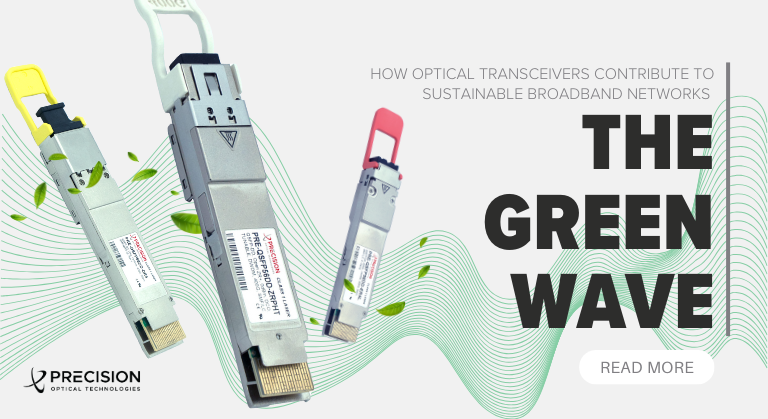
Navigating the Next Wave: 400G ZRx Network Applications

In Part 1 of our 400G ZRx blog series, we shared the basics of what 400G ZRx is and what types of products fall into this category. Now we’re ready to dig further into this exciting coherent technology looking at various 400G ZRx network applications including grey links, amplified vs unamplified, and power link budget calculations. The applications enabled by 400G ZRx products represent a significant advancement in optical networking technology, enabling faster, more efficient, and scalable solutions to meet the demands of modern data-intensive applications and services.
Grey + Unamplified Links for 400G ZRx
A grey link is just a straight fiber link, point-to-point, with no DWDM MUX/DEMUX (Dense Wavelength Division Multiplexing/Demultiplexing) and no amplification. With 400G ZRx optics such as the ones we presented previously, a grey link can be formed and a simple power link budget calculated as follows by subtracting the receiver (RX) sensitivity from the transmitter (TX) output power:
Power Link Budget = (TX Power) – (RX Sensitivity)
- PRE-QSFP56DD-ZR à -10 dBm – (-18 dBm) = 8 dB
- PRE-QSFP56DD-ZRHT à 0 dBm – (-20 dBm) = 20 dB
- PRE-QSFP56DD-ZRXT à +4 dBm – (-20 dBm) = 24 dB
To estimate the distance attainable for a particular grey link, one must also consider factors such as fiber loss as shown below in Table 1. Here we have estimated, for example, a loss level of 0.25 dB/km for older fiber out in the field. For newer fiber, such as one we have in our lab (no splices, no issues, new untouched fiber) we can represent the loss as ~0.2 dB/km. And then estimating the typical or average value for fiber loss at DWDM C-band, we’ll use 0.22 dB/km.
Table 1 Theoretical Max Distance(km) for Link Budget vs Fiber Loss
We then calculated the theoretical Max Distance attainable in km for each combination of link budget and fiber loss for each 400G ZRx module shown in Table 1.
DWDM Unamplified Links for 400G ZRx
A slightly different application to consider is an unamplified grey link with MUX/DEMUX added to the system. For the sake of simplicity we are using the TX and RX specs when using the 400G OFEC DP-16QAM application from a PRE-QSFP56DD-ZRPHT. Lower data rate applications can have better power link budget margins.
A basic power link budget calculation can be made as in this example:
PRE-QSFP56DD-ZRPHT à +1 dBm – (-22 dBm) = ~23 dB
And then we need to consider the MUX/DEMUX insertion losses (IL) from both sides of the link and factor those into our calculation. Table 2 shows the Theoretical Max Distance in km obtainable for different combinations of Link budget vs Fiber Loss using different MUX+DEMUX configurations with PRE-QSFP56DD-ZRPHT (@400G OFEC DP-16QAM) transceivers on each side:
Table 2 Theoretical Max Distance(km) for Link Budget vs Fiber Loss for various MUX+DEMUX Configurations
As an example as seen from the table, using PRE-QSFP56DD-ZRPHT transceivers, and an 8 channel MUX+DEMUX, you would be able to reach between ~70 to 80 km unamplified, point to point.
Amplified Links
Next we’ll look at amplified links in which we typically will have DWDM MUX/DEMUX (either passive or via ROADMs) plus some sort of amplification, typically EDFA (Erbium Doped Fiber Amplifier) or Raman amplifiers.
Figure 1 Ex. 400G ZRx Application with DWDM MUX/DEMUX and Amplification
In this case we’re going from a power link budget calculation to an OSNR(Optical Signal to Noise Ratio) link budget calculation. The OSNR will be degraded by the noise figure (NF) of each amplifier included in the optical network design.
Key parameters for this type of optical network design include:
a.) TX output power
b.) Transmitter OSNR
c.) OSNR tolerance at the Receiver
d.) Chromatic Dispersion tolerance at the Receiver
Figure 2 Visual Representation of Amplification using an EDFA
In this scenario shown in Figure 2, you have several multiplexed signals as input into the amplifier. Those signals will go through an amplifier — in this case, an EDFA – and the all the signals are amplified, including the noise (as depicted by the grey area). For every amplifier in the network, the signal will be amplified along with the noise. Plus, the noise figure of each amplifier will limit the OSNR after each amplification stage. So the OSNR budget keeps decreasing at each amplification span and that is ultimately THE main limitation on this type of network application.
About Precision OT
Precision OT is a systems engineering and integration company focused on optical transceivers and related active/passive optical components. When it comes to deploying 400G ZRx in your network, Precision OT understands there’s not a one-size-fits-all approach. With a deep-seated expertise in interoperability and system integration, Precision OT can help determine which 400G ZRx product is best for your application and ensure a high-quality, complete end-to-end solution for your network.










